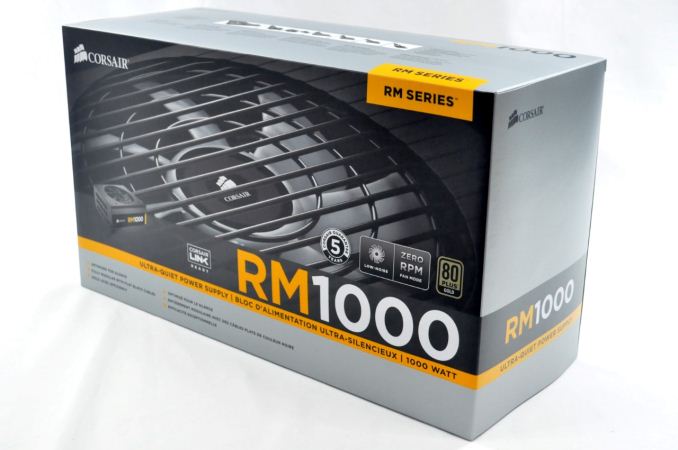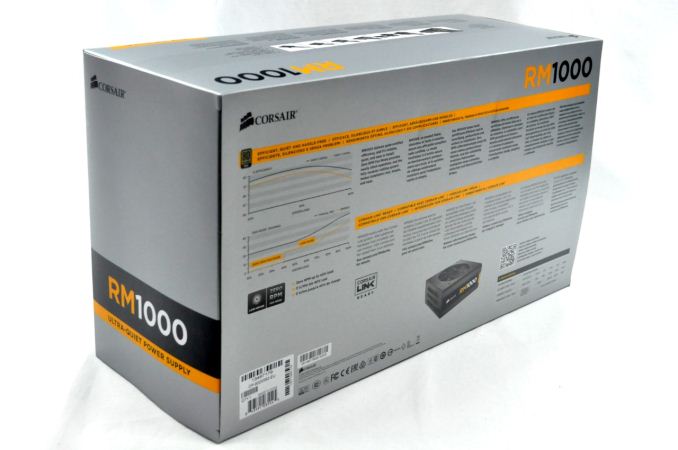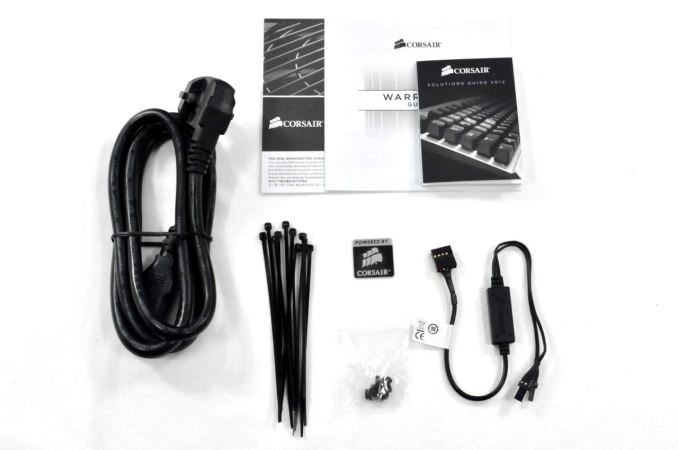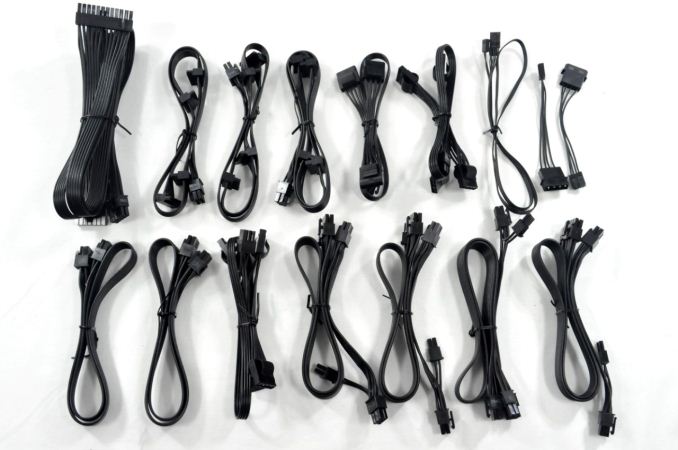Corsair RM1000 Power Supply Review
by E. Fylladitakis on April 24, 2014 6:00 AM EST- Posted in
- Cases/Cooling/PSUs
- Corsair
- PSUs
- RM Series

Introduction
Corsair has created a good reputation for their branded PSUs, and today they are among the most popular choices for gamers and enthusiasts. The first PSU from Corsair to find its way into our new testing lab is the RM1000, an 80 Plus Gold Certified unit with a rated output of 1000W at 40°C ambient. Given the rated power output and retail price of $169.99 after rebate, the RM1000 is understandably targeted at advanced users and gamers, and very few PCs require so much power. The target audience can be quite demanding, however, and a simple 80 Plus Gold certification is not enough to entice such users, so let's see what else Corsair has up their sleeves.
The RM series PSUs are optimized for silence and there are currently six models, ranging from 450W to 1000W. That makes the RM1000 the most powerful model of the series but it also is significantly different from the less powerful models as well. In fact, it's almost entirely different. The 750W and the 850W models come from a different ODM, as they are based off of Chicony Electronics designs, while Channel Well Technologies (CWT) supplies the other four models. As such, the RM1000 and the RM450/RM550/RM650 are all based on a CWT design, yet the RM1000 we're looking at is based on a different platform than that of the lower wattage models.
Corsair has had many CWT derived designs in the past and most of them were very popular among advanced users. However, times have changed and there is stiff competition in the market right now, especially in this particular segment, as every single manufacturer apparently wants a high performance 1000W model as their halo product, and the market has been virtually flooded with such PSUs. Not surprisingly, it's no longer possible to compete at the top of the market by simply offering a "high performance" PSU. Let's have a thorough look at the RM1000 and see what it can offer to consumers and where it falls short.
Packaging and bundle
We received the Corsair RM1000 inside a large, interestingly designed cardboard box. Most of the box is grey with yellow colored accents, the series' trademark. The front and sides of the box are relatively tidy, with badges and summarized descriptions of the most important features. The rear of the box offers a wealth of information regarding the performance of the power supply, summarized in charts and a table rather than tons of marketing text.
The Corsair RM1000 bundle is adequate, but it could have been better for a unit of this class. Alongside the power cord, manual and screws, Corsair also supplies a few cable ties, a case badge with the company's logo, a Corsair Link interface cable, and an advertising leaflet.
As this is a high output, fully modular unit, numerous cables are supplied alongside the PSU. All of the cables, including the ATX connector, are black ribbon cables without sleeving. Some will say they look significantly better than sleeved color-coded wires and require less space, though that's a matter of personal preference. while it looks like Corsair chose not to include a bag for the extra cables, the body of the unit itself comes wrapped inside a pouch for protection during shipping, and this pouch can be used to store the cables later on.














55 Comments
View All Comments
tynopik - Thursday, April 24, 2014 - link
where's the cart with cable lengths and connector spacings?poohbear - Thursday, April 24, 2014 - link
so, in 2014, what kind of system actually needs 1k wts? CPUs and Graphics cards are as power efficient as ever, so what are people doing with these 1k psus? My GTX 670s in SLI pull 300wts together under load, the newer graphics cards are even more power efficient, so what gives?peterfares - Friday, April 25, 2014 - link
mining coinsmeacupla - Saturday, April 26, 2014 - link
You're not supposed to load it up fully, because efficiency drops off.Generally, what you want to do is load up the PSU so that it's operating near peak efficiency where the computer is going full tilt. If you run an overclocked i7 and a pair of 780 cards, I think that gets you into the 600W range, or 60% load for this PSU, which is around the peak efficiency for it.
Antronman - Saturday, April 26, 2014 - link
2-way water OC SLI/CF with high-end cards+ CPU OC on water.600-700w power draw easily, and then another 80w+ for the monitor, plus 10w for each USB device.
ba-bam, you need a 1000w PSU.
royalcrown - Monday, April 28, 2014 - link
Except the monitors don't run off the psu ;)tabascosauz - Friday, April 25, 2014 - link
I had hoped that the higher wattage RMs (850W and now 1000W) would trade CapXon/TAICON/Teapo caps for Chemicon/Rubycon ones and the zero rpm fan profile for an even quieter fan, but I guess one can't always get what he wishes for.The thing is, at this price range there's just so much competition. You have absolutely stunning 80+ Gold and Platinum 1KW+ platforms from Super Flower, Seasonic, and Delta that don't miss a beat when it comes to high quality components and impeccable solder jobs. This makes the RM a lot less attractive (well, it does look nice on the outside but most other KW+ units also look nice).
YoloPascual - Friday, April 25, 2014 - link
^+1This psu has a zero rpm mode. The heat will f**k up those capxon and taicon. RM1000w is $190 now in newegg, EVGA G2 1000w $200 , Cooler Master V1000w $210.
Those who got more than 2 gpus will not bother to expend 10-20$ more if they can a much better psu. IF those people know more, not just brand names.
jonnyGURU - Friday, April 25, 2014 - link
I disagree. Not only are these caps rated at 105°C, but the temperatures inside the PSU don't get anywhere near that. Remember that the life of the cap increases exponentially the cooler it is from it's max rating.Also, Japanese caps are quite over-rated. They're not even made in Japan anymore (they're just Japanese brand) and the Chinese are using the same Japanese electrolyte and aluminum that the Japanese brands are using.
tabascosauz - Friday, April 25, 2014 - link
Well, manufacturers can obviously RATE their caps at the temperature they want them to be rated, but not all of them will deliver. Teapo has been in the game for quite a bit of time and now it's pretty much agreed that they are capable of delivering on the same level as the Japanese ones, but it's the TAICON and CapXon ones that are a little less sure.I do agree that even with a zero rpm fan mode, there's still a pretty capable fan on the RM. That's the reason why I would never buy a Seasonic fanless PSU for any reason. I must say that I haven't seen many 1000+ units from CWT and don't know how they fare (from the soldering jobs that they do I would say that CWT needs some more experience in the high end market, although it shouldn't really affect performance), Seasonic, Delta and to a certain extent Super Flower can claim their superiority here.
Are you OklahomaWolf or are you just a fan of jonnyGURU? That site is one of my go-to places for an education on PSUs, aside from TPU. All the others are pretty much junk.